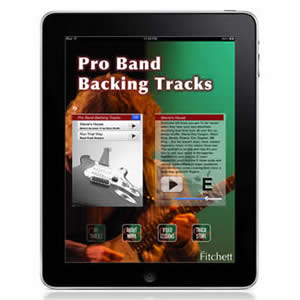Million Licks
| Learn Some Licks & Jam With Pro Band Tracks
If you are a musician who is learning to improvise, there is nothing greater than jamming with live musicians. However, when your band is not available when the you feel like throwing down some licks Pro Band backing tracks is the answer. It's like a band in your pocket. |
|
|
Individual tracks & bundles. 16 Rock & Blues styles. |
|
Blues Styles |
|
Acoustic Blues |
| The Ultimate Blues Collection |
| Modes Trainer |
| Eclectic Tracks |
| Jazz ii-V-I Trainer |
|
27 tracks minus bass |
|
27 tracks minus drums |
 |
 |
 |
 |
|
|
||
Million Licks Blues Shuffle Are you ready for an amazing breakthrough in Guitar Lick Technology? What if someone told you they could easily teach you how to play 100 consistent, structured awesome sounding blues/rock licks? How about a 1000 or 10,000, but why stop there? This insane ground-breaking little app can show you how to play 1,000,000+ licks! Pick a key, tempo and a backing track, run the random lick generator and the app plays and tabs endless variations. Hear something you like? Save it to the library or tweak it first. Everything you save can be called up later to be practiced at slower (or faster) tempos or in different keys. Want to build something from scratch? Easy! Just pick from the list of licks and experiment away. What goes into making a great solo? When soloing are you randomly running notes across the neck, and every once in awhile playing something you think might have sounded pretty cool? It happens! The problem is when you have no idea what you just did, why it worked, and even worse how to duplicate it. If you’re like most guitarists first starting to improvise your solos probably seem to have little or no form and you feel like you’re just rambling. Million Licks is a radical departure from learning a phrase by rote and then moving on because it actually shows you the finer details of what goes into a well crafted phrase and teaches you how to create variations within that phrase. Why? Because the really great improvisers know how to take a good idea and construct variations built upon spontaneously recombining their smaller pre-learned bits to create larger ones as well as morphing into new ones. And of course they’re doing all this while executing clear, concise, longer articulate phrases which have a definitive beginning and end. How do they do that? Million Licks is based on the knowledge that so many great solos are created from back to back 8-beat (2 measure) phrases, and that the building blocks of these larger phrases are small 1 and 2 beat improvisational ideas. We take some of the best classic guitar lick ideas from the blues and rock shuffle world, teach them to you, and then show you how to spontaneously recombine permutate and modify them in any order to ultimately create your own original phrases and licks. Open your ears and fingers to the endless possibilities! Features Tab in all keys Library of phrases Free lick updates Backing tracks Loop function Tempo control Save a lick Create a lick Permutate a lick Mix lead and track levels
|
|
|
Most solos are back to back 8-beat phrases (2 measure phrases). Whether conscious of it or not, the majority great guitarists naturally create phrases this length. A typical one chorus blues solo is 12 measures which mean the soloist will usually play six 2-measure phrases per chorus. Many rock songs have solos that are 8 measures (= 4 phrases), or 16 measures (= 8 phrases). Phrases can be any length but getting absolute control over a 2-measure phrase is the key to learning how to add organization to a solo. Eventually your creativity will take you wherever it wants to go. Most blues and rock phrases are combinations of small 1 and 2 beat ideas we refer to as “isms” (as in bluesisms), and are what contributes to a style’s recognizable sound. These isms include scale combinations, sequential patterns, rhythmic variations, hammer-on and pull-off ideas, bends, slides and vibratos. Add in permutations of all of the above and the possibilities are endless.
|
||





